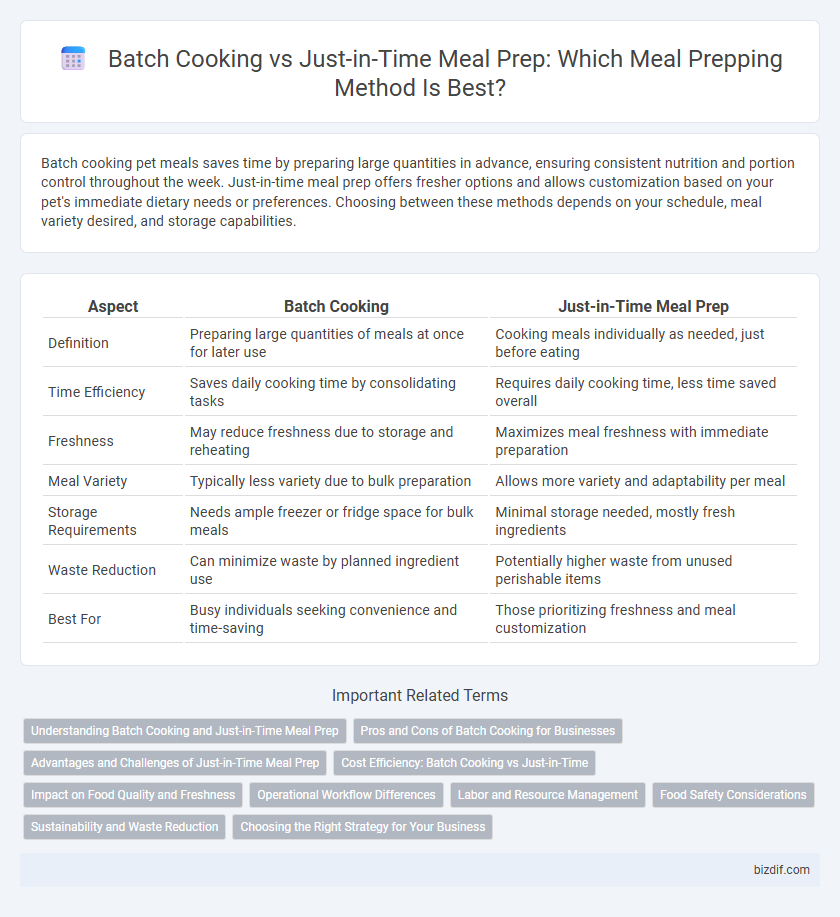Batch cooking pet meals saves time by preparing large quantities in advance, ensuring consistent nutrition and portion control throughout the week. Just-in-time meal prep offers fresher options and allows customization based on your pet's immediate dietary needs or preferences. Choosing between these methods depends on your schedule, meal variety desired, and storage capabilities.
Table of Comparison
| Aspect | Batch Cooking | Just-in-Time Meal Prep |
|---|---|---|
| Definition | Preparing large quantities of meals at once for later use | Cooking meals individually as needed, just before eating |
| Time Efficiency | Saves daily cooking time by consolidating tasks | Requires daily cooking time, less time saved overall |
| Freshness | May reduce freshness due to storage and reheating | Maximizes meal freshness with immediate preparation |
| Meal Variety | Typically less variety due to bulk preparation | Allows more variety and adaptability per meal |
| Storage Requirements | Needs ample freezer or fridge space for bulk meals | Minimal storage needed, mostly fresh ingredients |
| Waste Reduction | Can minimize waste by planned ingredient use | Potentially higher waste from unused perishable items |
| Best For | Busy individuals seeking convenience and time-saving | Those prioritizing freshness and meal customization |
Understanding Batch Cooking and Just-in-Time Meal Prep
Batch cooking involves preparing large quantities of meals or components at once, maximizing efficiency and reducing daily cooking time by storing portions for later use. Just-in-time meal prep emphasizes cooking meals in smaller quantities shortly before consumption, ensuring freshness and customization to immediate dietary needs. Both methods optimize meal planning but differ in time management, food quality, and convenience factors.
Pros and Cons of Batch Cooking for Businesses
Batch cooking enables businesses to prepare large quantities of meals in advance, reducing labor costs and minimizing daily food preparation time. However, it can lead to increased inventory management challenges, potential food waste, and reduced menu flexibility due to fixed batch sizes and limited dish variety. Proper storage solutions and demand forecasting are essential to maximize the efficiency and profitability of batch cooking in commercial meal prep operations.
Advantages and Challenges of Just-in-Time Meal Prep
Just-in-time meal prep offers the advantage of fresher meals by preparing food shortly before consumption, reducing waste and allowing for greater menu flexibility based on daily preferences or ingredient availability. However, it demands more daily time investment and quicker cooking skills, which can be challenging for individuals with busy schedules or limited culinary experience. This approach also requires precise planning and efficient kitchen organization to ensure timely meal preparation without compromising quality.
Cost Efficiency: Batch Cooking vs Just-in-Time
Batch cooking significantly reduces overall meal costs by purchasing ingredients in bulk and minimizing energy use per meal, making it ideal for budget-conscious individuals. Just-in-time meal prep may incur higher expenses due to frequent small purchases and possible ingredient waste but offers fresher meals tailored to immediate needs. Cost efficiency in meal prepping depends on balancing bulk savings from batch cooking against the flexibility and freshness provided by just-in-time strategies.
Impact on Food Quality and Freshness
Batch cooking preserves nutrients and flavors by minimizing repeated reheating, which often degrades food quality and freshness over time. Just-in-time meal prep ensures optimal freshness and texture by cooking meals immediately before consumption, reducing nutrient loss and spoilage risks. Balancing batch cooking's convenience with freshness considerations requires careful portioning and airtight storage to maintain taste and nutritional value.
Operational Workflow Differences
Batch cooking streamlines meal preparation by producing multiple servings at once, reducing daily cooking time and maximizing kitchen efficiency. Just-in-time meal prep emphasizes cooking meals individually as needed, allowing for fresher dishes with more flexibility but requiring more frequent culinary efforts. Operational workflow differences highlight batch cooking's reliance on consolidated time blocks versus just-in-time's continuous, on-demand cooking process.
Labor and Resource Management
Batch cooking streamlines labor by concentrating meal preparation into fewer, extended sessions, optimizing time allocation and minimizing daily cooking effort. Just-in-time meal prep demands consistent, shorter labor periods, requiring efficient scheduling to manage fluctuating workloads and prevent resource bottlenecks. Resource management favors batch cooking through bulk purchasing and shared ingredient use, whereas just-in-time methods require precise inventory control to reduce waste and ensure ingredient freshness.
Food Safety Considerations
Batch cooking requires careful attention to cooling and storage temperatures to prevent bacterial growth, with meals ideally refrigerated below 40degF within two hours of cooking. Just-in-time meal prep minimizes the risk of foodborne illness by preparing meals close to consumption, reducing the window for contamination. Proper hygiene, cross-contamination prevention, and reheating to safe internal temperatures remain critical in both methods to ensure food safety.
Sustainability and Waste Reduction
Batch cooking minimizes food waste by utilizing bulk ingredients efficiently, reducing packaging waste and energy consumption through fewer cooking sessions. Just-in-time meal prep allows for precise portion control and fresher ingredients, lowering the risk of food spoilage and minimizing leftovers. Both methods contribute to sustainable eating habits by optimizing resource use and decreasing overall food waste.
Choosing the Right Strategy for Your Business
Batch cooking maximizes efficiency by preparing large quantities of meals in advance, reducing labor costs and ensuring consistent product quality, ideal for businesses with predictable demand patterns. Just-in-time meal prep offers flexibility and freshness by preparing meals shortly before delivery or sale, suitable for businesses prioritizing customization and minimizing food waste. Evaluating factors such as customer preferences, kitchen capacity, and supply chain reliability helps determine the optimal strategy for meal prep operations.
Batch cooking vs just-in-time meal prep Infographic

 bizdif.com
bizdif.com